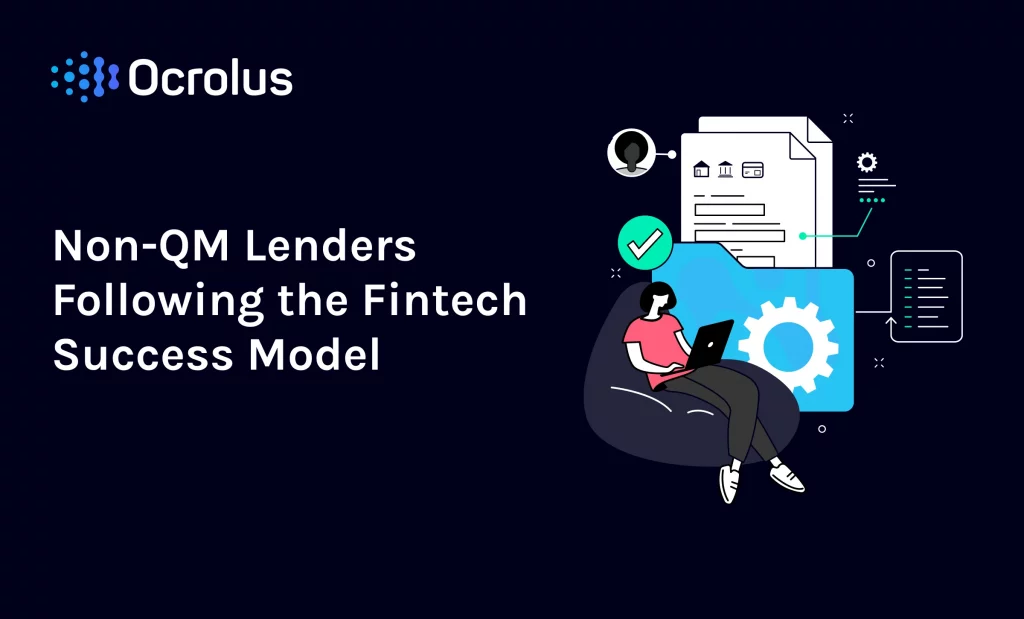This website uses cookies so that we can provide you with the best user experience possible. Cookie information is stored in your browser and performs functions such as recognising you when you return to our website and helping our team to understand which sections of the website you find most interesting and useful.
Non-QM Lenders Following the Fintech Success Model

The volume of US-based digital lending by fintechs to individuals and small/medium enterprise (SME) has grown from less than $21B in 2017 to an estimated $27B in 2019, and it’s projected to surpass $40B by 2022. This growth and the associated increase in fintech lenders’ market capitalization can be attributed to their product innovation and focus on underserved demographics.
Lenders offering non-qualified mortgages–mortgages that do not comply with the Consumer Financial Protection Bureau’s rules for Qualified Mortgages–are the fintechs of the mortgage industry. By servicing freelancers, small business owners, millennials and other mortgage borrowers that don’t meet traditional underwriting models, non-QM lenders have capitalized on opportunities largely ignored by depository institutions.
Sound familiar? That’s because it’s essentially what fintechs have done for borrowers who have struggled to secure personal and SME loans.
The resemblance doesn’t stop there. In targeting borrowers that traditional originators shun, non-QM lenders and fintechs have developed similar underwriting standards and operational efficiencies that enable them to dominate key markets ignored by the banks.
The Fintech Advantage: Underwriting Programs & Process Efficiencies Outflank GSE Mortgages
With banks locking millions of borrowers out of financing due to low or no FICO scores, fintechs reimagined the underwriting process by developing ways to validate income and assets from this rapidly growing subgroup. Instead of focusing on FICO and debt to income ratios, fintechs measured an applicant’s actual ability to repay a loan by calculating borrower cash flow, primarily from bank statements.
From humble beginnings, fintechs built systems that validated assets quickly, enabling them to generate impressive profits through process efficiency. Manual data extraction and “stare & compare” reviews were replaced by computer vision-based technology. Risk was reduced with AI-based anti-fraud technology; decisions were accelerated as borrower data extracted from financial documents was available in a structured format and fed directly into loan origination systems.
These core efficiencies empowered fintechs to dominate a market that most banks saw as too “risky.” And that’s exactly what is happening with non-QM lenders right now.
Non-QM Lenders Apply Fintech Mindset to Mortgage Underwriting
Just like fintechs, non-QM lenders operate in markets that are mostly untapped by the banks. Non-QM lenders target borrowers who cannot obtain a qualified mortgage, but who still have a demonstrated ability to repay loans. Think of a borrower who has a short credit history. Or a borrower with a job in the gig economy whose income comes from Paypal, Venmo, and other sources not always associated with regular pay stubs. By using other factors of creditworthiness beyond FICO and DTI, non-QM lenders service traditionally excluded mortgage borrowers such as:
- Millennials, who may have the income to support a mortgage, but lack credit history or savings.
- Baby boomers, who moved from paychecks to self employment during the past decade’s recession.
- Foreign nationals, who are underserved due to a lack of US-based credit and/or employment history.
Like fintechs, non-QM lenders use alternative methods to calculate a borrower’s ability to repay, including for income and assets. For instance, some of the borrowers featured in the bullet list will not have tax forms or traditional pay stubs to prove income, as required by GSEs. But they likely have several months’ worth of bank statements. In this case, non-QM lenders can use the underwriting strategies pioneered by fintechs, calculating borrower income by applying cash flow analysis to bank statements.
Non-QM lenders, like fintechs, operate with less resources, capital, and room for error than the banks. That’s why, much like fintechs, Non-QM lenders require innovative process efficiencies to generate significant profits. Consider the underwriting process from above, where borrower income is calculated from verified bank statements.
If a lender manually analyzes those bank statements, the speed and accuracy of the underwriting suffer. This means fewer mortgages per underwriter per month and the potential for overlooking signs of risky loans. But by automating bank statement analysis with attended machine learning (meaning human-in-the-loop programs that produce better results as questionable data is validated and fed back into the program), a non-QM lender can eliminate manual document review.
One issue that has been a concern for non-conforming loans is the ability to bundle the mortgages for the secondary market. Strong underwriting standards offer the most consequential similarities between fintechs and non-QM lenders. Even though both lender groups started by targeting “subprime” markets, non-QM loans, with their higher interest rates, represent an attractive investment class. With reliable, documented underwriting standards, the demand for non-QM mortgage-backed-securities on the secondary market is skyrocketing. Investors bought $12.3 billion of these non-QM securities in 2018, quadruple the rate from the previous year.
Fintechs & Non-QM Lenders: Growing Market Share Now and the Future
By targeting markets that the banks ignored, non QM-lenders and fintechs both developed new underwriting strategies and process advantages that enabled them to own these nontraditional markets. But more than that, these new efficiencies have positioned fintechs and non-QM lenders to compete, in the long run, with the very same banks that ceded this territory.
The efficiencies pioneered by fintechs, and now adopted in large measure by non-QM lenders, have allowed non-depository lenders to create a first to market advantage. As 2020 approaches, Non-QM lenders, the fintechs of the mortgage industry, are well-positioned to capitalize on the market influence of gig economy workers.
# # #
Tim Dubes is Vice President of Marketing with Ocrolus, a mortgage automation software provider that transforms documents and into actionable data with over 99% accuracy.






